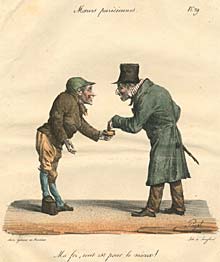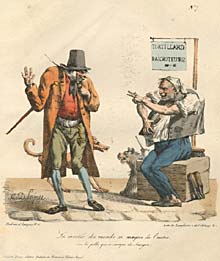French Caricature: Social Commentary & Scenes of the Day
In the nineteenth century, Paris, like London and Berlin, experienced an influx of people who spoke different dialects and languages, making communication difficult. In addition, only half of the Parisian population could read.1
What better way to convey ideas than through images? Caricature became hugely popular because it bridged both the language and the illiteracy gap better than the written word. Due to technological advances, caricature was also well suited to effect a rapid response to topical themes and events of the day. With the invention of lithography just before the turn of the nineteenth century, images were drawn directly on the lithography stone, rather than given to an engraver. The elimination of this extra step plus the increasingly mechanized printing press resulted in a visual form that could be published quickly.
Caricature can take many forms. It can be biting political satire or a commentary on the current social scene. It can mock one particular person, a social class, a public event, or an idea. Some of the images are as easily understood today as when they were first published. The twenty-first century finds people grappling with the same family matters, money issues, and emotions as their earlier counterparts, and a person facing a dose of unpleasant medicine today will make the same grimace as did a patient 200 years ago. However, other caricatures are packed with meaning directed specifically to the audience of the period and are less easily interpreted. The superficial implication might be obvious, but the more subtle political or social significance and thus the actual reason the artist drew the cartoon is sometimes lost on a modern viewer.
Parisians were attentive to visible clues of class, occupation, and character. This interest was fostered by late eighteenth-century theories of physiognomy, the technique of discovering temperament and character from the outward appearance, and phrenology, the study of the conformation of the skull as indicative of mental faculties and traits of character. 2

Ma foi, tout est pour le mieux! Edme Jean Pigal, (Mœurs parisiennes. No. 29.) Lith. de Langlumé, chez Gihaut et Martinet.
Edme Jean Pigal was one of many caricaturists who drew scenes of the day focusing on contemporary customs and sights along the streets of Paris. His early lithographs were vignettes featuring one or two characters, with little or no background.3
This image is number 29 in the series of 100 lithographs entitled, “Mœurs parisiennes” or “Parisian manners.” It shows two lower class men with the caption, “After all, everything is for the best.” The hunched man on the right does not look particularly prosperous himself, but is making a contribution to the character who has one shortened leg. Unlike most interchanges between beggar and benefactor, the encounter is a pleasant one in which each person faces the other with a smile. The two are eye-to-eye because of the giver’s humped back and the beggar’s elevated shoe.
The beggar’s shortened leg possibly resulted from polio, a primary cause of permanent disability before the advent of a vaccine in the mid 1950s. One of polio’s symptoms is paralysis. Any combination of limbs might be involved, but the most commonly affected extremity is one leg. An Egyptian stela, dated to a period ranging from 1580 BC to 1350 BC, shows a crippled man with one shortened and withered leg and suggests the probable presence of polio since ancient times.4

La moitie du monde se moque de l’autre, ou la pelle qui se mocque du fourgon. Lith. de Langlumé r. de l’Abbaye N, Noël rue st. Jacques N 16, Noël et Dauty éditeur Galerie de Nemours Palais Royal.
Caricatures sometimes illustrate a saying or proverb. The French proverb about the shovel that teases the fire-iron or poker corresponds well to the English adage of the pot calling the kettle black. This caricature has the caption, “One half of the world makes fun of the other, or the shovel that teases the fire-iron.” The two humpbacked, surly-looking figures strike confrontational poses. The character on the right sits under a sign that suggests he is a wily shoe shiner. The tools of his occupation surround him: an extra pair of shoes propped by his wooden seat, a brush, and a mug handy for storing shoe paste. With his outstretched arm and accusing finger he harasses the other man who aggressively responds to the attack. To further emphasize his point, the artist positions a snarling dog behind each figure. The dogs mimic the men in both expression and coloring.
![Misére, hypocrisie, convoitise. Misery, hypocrisy, covetou[s]ness Misére, hypocrisie, convoitise. Misery, hypocrisy, covetou[s]ness](../hist-images/caricatures/misery.jpg)
Misére, hypocrisie, convoitise. Misery, hypocrisy, covetou[s]ness. Grandville, (Les Métamorphoses du Jour. No. 14.), Lith. de Langlume. chez Bulla, rue St. Jacques, No. 38. Et chez Martinet, rue du Coq.
“Misére, hypocrisie, convoitise,” belongs to “Les Métamorphoses du Jour” or “Today’s Metamorphoses” series by Grandville, a pseudonym for Jean Ignace Isidore Gérard.
This series appeared originally in album form in 1829 and was Grandville’s first major success.5
Grandville created lithographs so that the white areas would lend themselves to watercolors painted by a coloriste, generally a poorly paid woman.6
A master of transformation, Grandville placed animal heads on human bodies to exhibit people’s animalistic characteristics and to satirize human airs and posturing. In this print a mouse on his deathbed represents misery. Using a handkerchief to wipe his eyes, the cat pretends to grieve. In actuality, he is a symbol of hypocrisy as cats are more likely to facilitate the death of mice than to mourn their loss. The three characters standing to the right look like crows and represent covetousness. Crows are scavengers and eat everything from bugs and berries to roadkill and stolen eggs. They also capture and eat small animals, such as the mouse in Grandville’s picture. The three crows have distinctive dress and, from left to right, probably signify the church, the nobility, and the state.7 All of these, like the crow searching for carrion, seem to be waiting for the mouse to die so they can swoop in and take the possessions and property of the helpless victim.